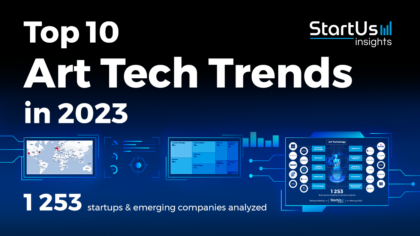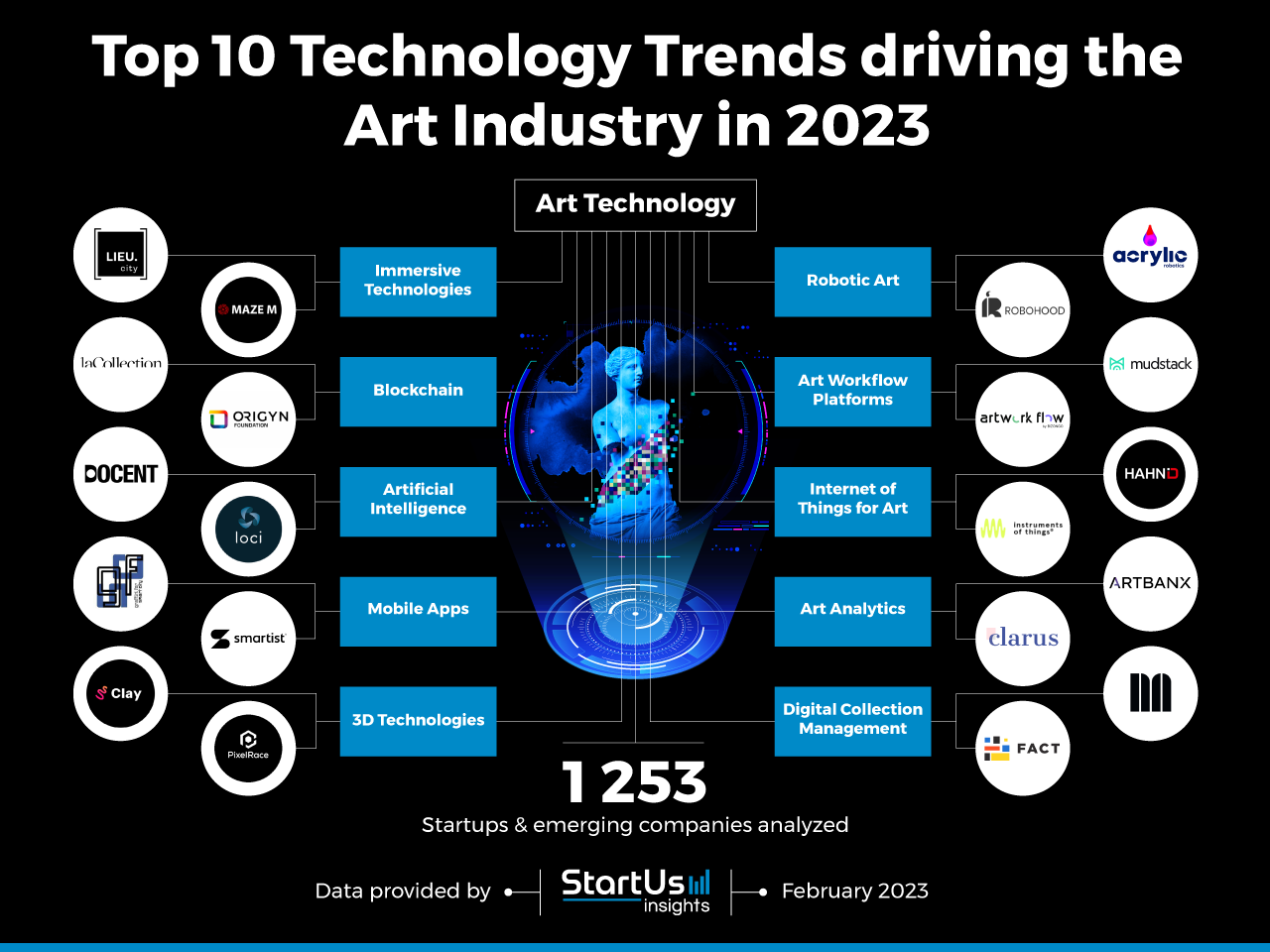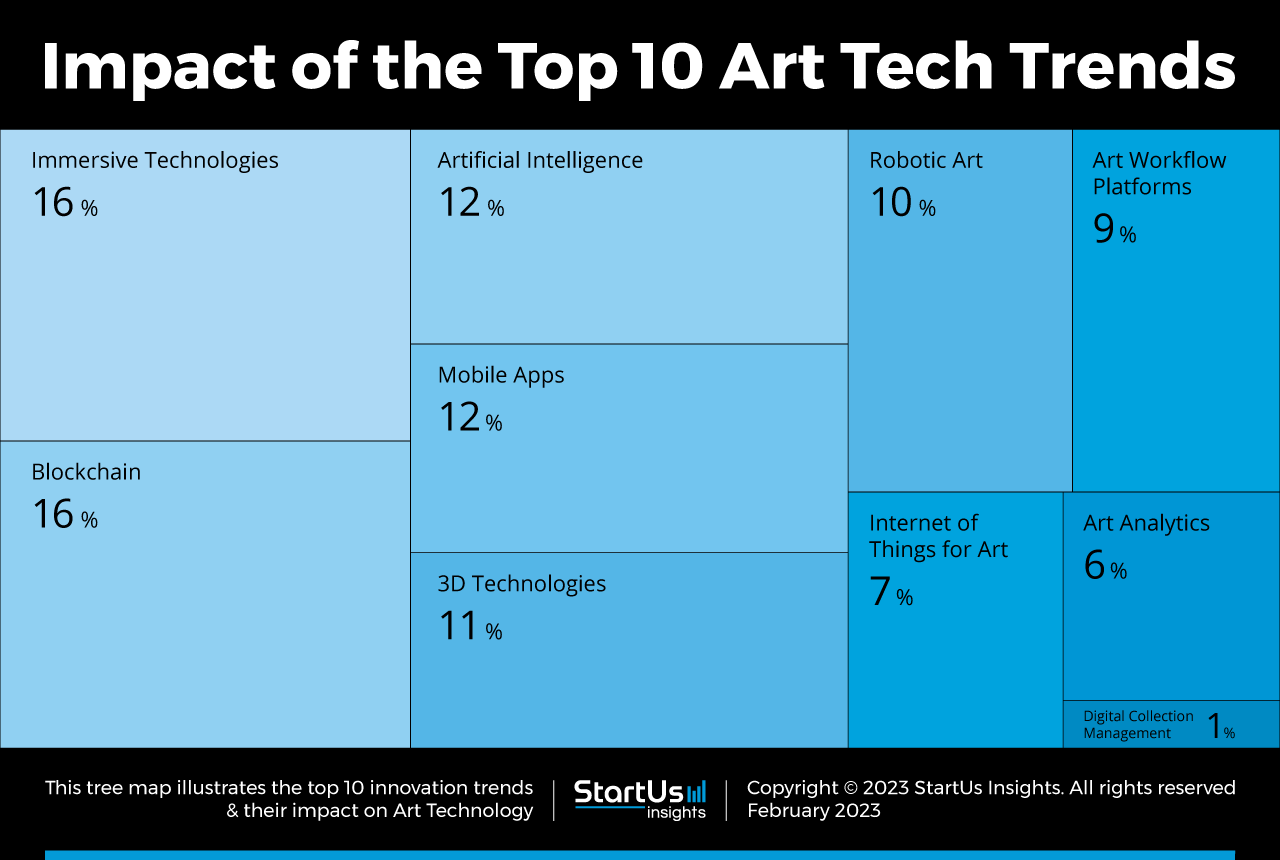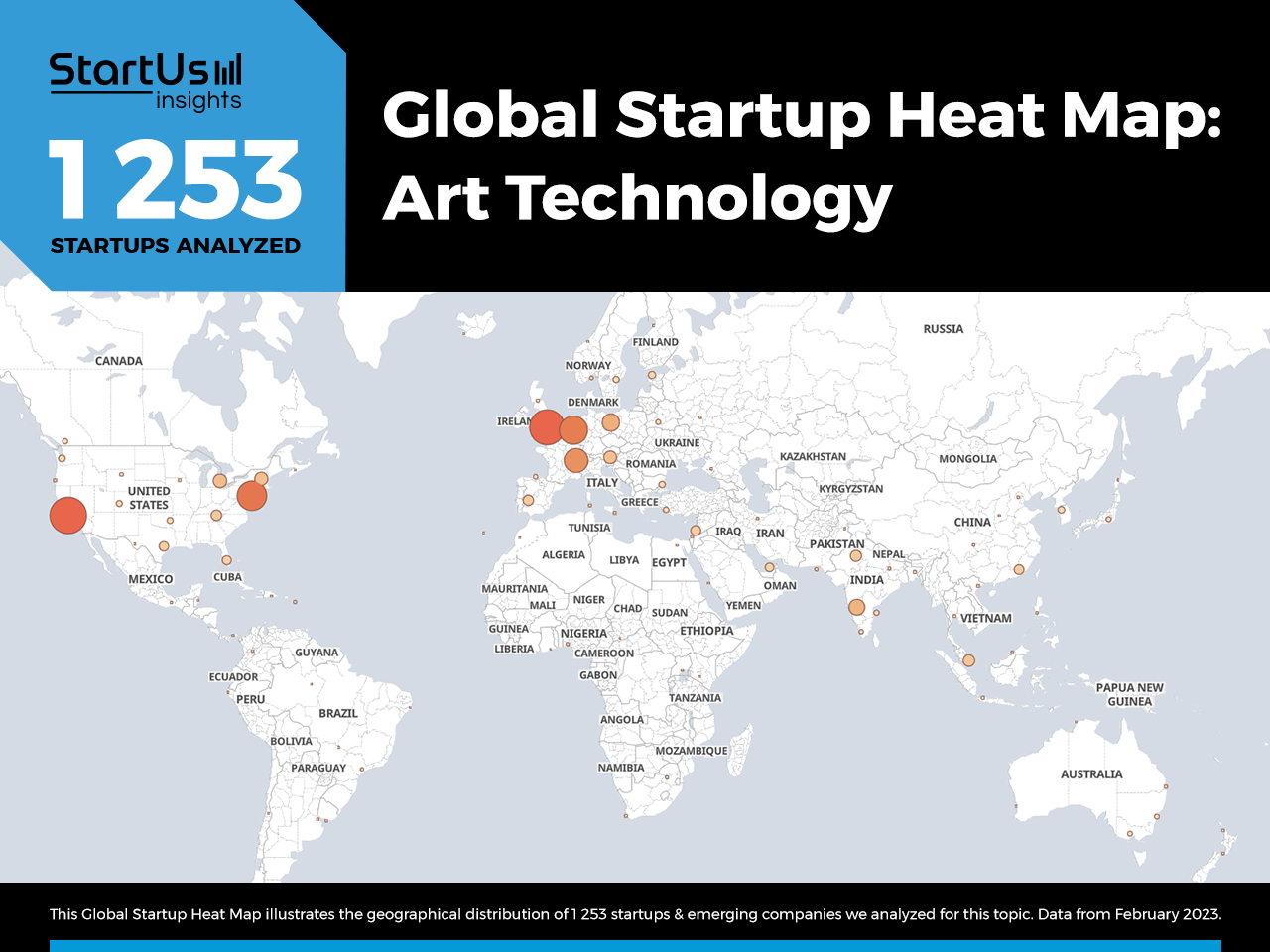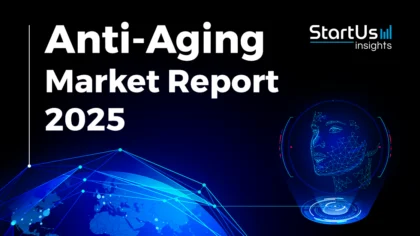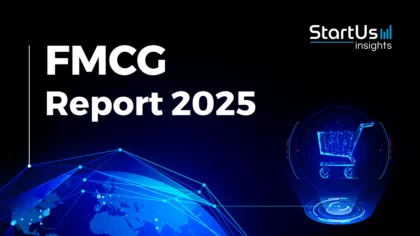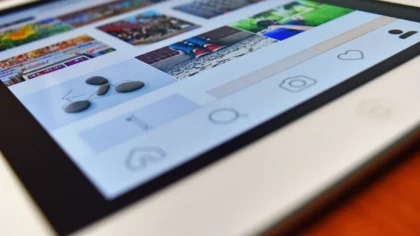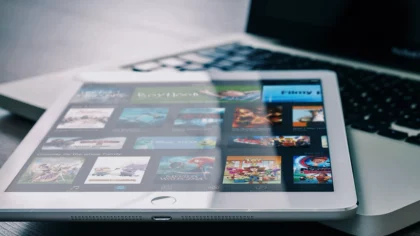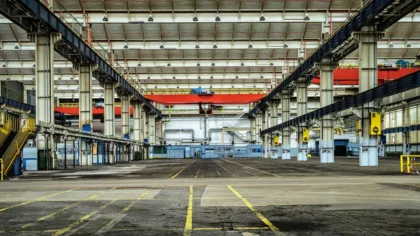Accelerate Productivity in 2025
Reignite Growth Despite the Global Slowdown
Although the art and technology worlds usually stand apart, post-pandemic effects push businesses to rethink the potential of its hybridization. The continuous digitization of societies is opening new playgrounds for art through virtual worlds and new methods of trading. Startups and scaleups are bringing technological advances such as digital art, non-fungible tokens (NFT), gamified museums, and 3D artwork scanning. This article provides an overview of the top global 10 art tech trends in 2023. They range from blockchain and immersive technologies to big data and robotization. Read more to explore the latest developments in the art industry and how they impact your business.
Innovation Map outlines the Top 10 Art Tech Trends & 20 Promising Startups
For this in-depth research on the Top Art Tech Trends & Startups, we analyzed a sample of 1 253 global startups & scaleups. The result of this research is data-driven innovation intelligence that improves strategic decision-making by giving you an overview of emerging technologies & startups in the art industry. These insights are derived by working with our Big Data & Artificial Intelligence-powered StartUs Insights Discovery Platform, covering 2 500 000+ startups & scaleups globally. As the world’s largest resource for data on emerging companies, the SaaS platform enables you to identify relevant startups, emerging technologies & future industry trends quickly & exhaustively.
In the Innovation Map below, you get an overview of the Top 10 Art Tech Trends & Innovations that impact 1 253 companies worldwide. Moreover, the Art Tech Innovation Map reveals 20 hand-picked startups, all working on emerging technologies that advance their field.
Top 10 Art Tech Trends in 2023
- Immersive Technologies
- Blockchain
- Artificial Intelligence
- Mobile Apps
- 3D Technologies
- Robotic Art
- Art Workflow Platforms
- Internet of Things for Art
- Art Analytics
- Digital Collection Management
Tree Map reveals the Impact of the Top 10 Art Tech Trends
Based on the Art Tech Innovation Map, the Tree Map below illustrates the impact of the Top 10 Art Tech Trends in 2023. Startups and scaleups are developing blockchain solutions to protect artworks from fraud and develop NFT-based trading systems. Immersive technologies and mobile apps aid artists and museums to create virtual multi-sensory experiences. With 3D technologies, artists improve their techniques while museums scan art pieces for further preservation. Other technologies, such as artificial intelligence (AI) and art analytics, offer market and visitor insights to empower investors in financial strategies. Meanwhile, digital collection management and robots simplify artwork creation, handling, and archiving for collectors and dealers. Lastly, art workflow platforms and the internet of things (IoT) assist art businesses in data management.
Global Startup Heat Map covers 1 253 Art Tech Startups & Scaleups
The Global Startup Heat Map below highlights the global distribution of the 1 253 exemplary startups & scaleups that we analyzed for this research. Created through the StartUs Insights Discovery Platform, the Heat Map reveals that Western Europe and the US see the most startup activity.
Below, you get to meet 16 out of these 1 253 promising startups & scaleups as well as the solutions they develop. These art tech startups are hand-picked based on criteria such as founding year, location, funding raised, & more. Depending on your specific needs, your top picks might look entirely different.
Top 10 Art Tech Trends in 2023
1. Immersive Technologies
The development of immersive technologies transforms the art market by enabling multi-sensory experiences. Besides, extended reality (XR) plays a key role in virtualizing museums and exhibitions, accelerated by the pandemic. With VR, art lovers explore their favorite artworks in home at significantly reduced costs. By bringing works outside traditional spaces, AR and metaverse extend the interaction between artists and viewers. It also makes art more accessible for people with disabilities by creating virtual versions of museums, events, concerts, and performances. Further, artists develop new-media concepts and installations that are more participatory and interactive. This way, immersive approaches allow museums and artists to capture new audiences and build emotional engagement. Consequently, immersive technologies increase participation and generate new revenue streams.
Maze-M simplifies Museum Gamification
Bulgarian startup Maze-M creates a platform to enhance museums with immersive video games. It offers bespoke end-to-end content development based on AR and VR, 3D art modeling, 2D animations, character design, etc. For instance, while users explore ancient sites they also search for NFT artifacts around the city. These crafted gamified environments allow museums and cultural sites to preserve heritage value. Additionally, this allows them to deliver in-home experiences and attract wider and younger audiences.
LIEU.city enables VR Exhibitions
Italian startup LIEU.city develops a software program to generate VR exhibitions. It creates virtual rooms with hanging artworks curated according to museum preferences. Further, the startup provides museums with 3D models of actual places, guided tours, and interactive teaching for young enthusiasts. This way, LIEU.city enables museums to create fully immersive virtual spaces with reduced expenses on travel, accommodation, and setup.
2. Blockchain
One of the art industry’s greatest challenges is verifying the authenticity and provenance of artworks. To overcome this, startups and scaleups are offering secured cryptography and smart contracts. These advances improve the traceability of high-value artworks by converting them into NFTs. Blockchain resolves counterfeit generation and guarantees intellectual property protection by storing copyright information such as records, certificates, appraisals, etc. Cryptocurrencies are also enabling secure ways of purchasing, trading, and auctioning. For instance, museums and galleries raise money without high-interest loans with fractional ownership. Moreover, the anonymity of blockchain transactions allows traders to operate privately. As a result, blockchain allows artists, collectors, and investors to monetize their creations easily and transparently, thus boosting digital art.
laCollection creates an NFT Platform
French startup laCollection connects art institutions with collectors through its NFT platform. It utilizes digital lithography to create digital twins of artworks. The platform then issues authenticated NFT certificates for these digital versions. This allows collectors to own blockchain-certified art pieces from worldwide museums, galleries, and artists. By doing this, laCollection creates virtual ownership with alternative ways to buy, sell, and auction the artworks. Besides, NFT attracts a new audience and younger generation for museums, resolving demographic problems and creating new revenue streams.
ORIGYN generates NFT Biometric Certificates
Swiss startup ORIGYN certifies art pieces with the owner’s biometric information. The startup’s decentralized platform generates NFT certificates via a digital twin. It runs on the internet computer (IC), an internet-scale and web-speed public blockchain with advanced cryptography. The IC hosts large amounts of data inside smart contracts, so all processes stay within the blockchain. Further, art experts validate the minting process, providing enhanced transparency and credibility. This way, ORIGYN empowers stakeholders in digital media and collectibles with fractional NFT ownership for a wider pool of investors.
3. Artificial Intelligence
AI simplifies repetitive production processes and data processing workflows faster in the art industry. New forms of generative AI imitate painting styles or even create new ones. The GPT3 AI Dall E is a great example of how AI generates original artwork. This helps amateurs to produce images, sounds, and texts in shorter times, pushing back the boundaries of artificial creativity. Machine vision also recognizes, classifies, and recommends artworks based on user preferences. Further, startups develop chatbots and analytics tools to improve the visitor experience in museums and art galleries. For instance, AI predicts the number of no-shows and adapts the number of tickets in advance to increase capacity. AI-powered digital twins preserve and replicate delicate objects through photogrammetry. This way, AI enables museums and art collectors to eliminate inefficiencies and realize cost savings in art management.
Docent provides ML-based Art Recommendations
French startup Docent applies machine learning to create personalized art recommendations. The startup sources reliable and accurate information about artists to train the algorithms. Its computer vision algorithms then evaluate aesthetic and visual characteristics. By combining with natural language processing (NLP), the algorithms analyze text-based information to capture the themes and topics within artistic practices. This way, Docent enhances knowledge of contemporary art, helping institutions and private collections to raise interest among viewers.
Loci enables Automated 3D Asset Search
UK-based startup Loci uses AI to automate 3D asset discovery. The startup’s solution allows users to tag, search, and recommend 3D assets through flexible taxonomies. It also features a neural search engine that returns relevant results without manual tags. Additionally, visual search finds 3D assets based on the uploaded images of desired objects. This way, Loci’s solution automates interactions with visual assets, saving significant time for 3D artists in sorting and organizing work processes.
4. Mobile Apps
The expansion of wireless network connectivity opens new opportunities for the art world by shifting experiences to mobile. 5G’s high data speeds and low latency make smartphone-optimized artworks more accessible. 5G-enabled mobile apps offer safe, customizable, and engaging features such as extended reality and interactive maps with artist and artwork information. 5G also enables IoT networks for effective cross-device communication, improving audience engagement and offering customer-specific data.
Graffiti for Smart City provides 5G-enabled Digital Murals
Italian startup Graffiti for Smart City installs 5G-enabled digital murals in cities. To compose smart walls, the startup uses thin bio-based tiles while 5G allows fast connection to them via smartphones. This way, IoT-embedded murals allow users to discover points of interest, receive information, and more. Besides, users are also able to digitally paint on city walls, create artwork, and share them. Thus, 5G digital murals enable city governors to redevelop urban areas, create communities, and provide services to citizens.
Smartist builds an Art Showcasing App
US-based startup Smartist develops an app to place art pieces in realistic and customizable environments. Users upload the art and the app’s smart cropping feature straightens it without distortion. Additionally, the app supports more than 200 environments with editable wall colors, floor textures, and lighting while delivering multiple angle previews and automatic shadow adjustments. This approach simplifies realistic online visualization for artists to empower their marketing strategies and grow sales.
5. 3D Technologies
3D modeling, scanning, printing, and sculpting enable new opportunities for the creative industry. From 3D artwork models to 360-degree storytelling, 3D technologies increase satisfaction rates and audience engagement. Also, curators and historians use high-resolution 3D laser scanning to record the colors and geometries of paintings. This allows them to digitally preserve high-resolution information. Together with 3D printing, museums are able to handle, archive, and reproduce artworks more effectively. It is especially useful to tackle cultural heritage sites in architecture and restoration projects. Further, 3D printing makes otherwise labor-intensive tasks more time-effective for visual artists and sculptors. As a result, 3D technologies help artists, collectors, museums, and art handlers to scale up creative industries in a fast and safe manner.
Clay delivers Collaborative 3D Design Software
US-based startup Clay offers collaborative 3D design software for artists. It allows users to organize, share, and review 3D models in a centralized way. The platform also enables artists to leave notes and paint over without sending screenshots, making communication faster. Further, users control access to internal and external collaborators to protect visible and editable content. As a result, artists are able to create 3D models in real time, accelerating content production workflows.
PixelRace produces 3D Scanned Film Assets
Polish startup PixelRace provides virtual film production technology to 3D scan products. The real-time virtual production consists of computer-generated photo-realistic environments rendered and synchronized with physical scenography. To create high-quality 3D scans, the startup utilizes the Unreal Engine. PixelRace thus makes filming easier, resulting in shorter shooting time, reduced number of employees, and lower production costs.

6. Robotic Art
Robotization delivers novel forms of art creation ranging from music-playing robots to robotic painting and choreography. In combination with AI and ML, startups train robots to learn, analyze, and collaborate with human artists to replicate painting styles. Apart from artistic endeavors, humanoid robots are helpful in museums with visitor navigation, removing language barriers, and improving knowledge sharing. Further, robotization makes the recreation of shattered artifacts in archeological sites possible. All these advances enable artists, curators, and museums to enhance their portfolios while making them more cost-effective.
Robohood offers Robot-made Paintings
US-based startup Robohood develops robotic painting technology using AI algorithms. The startup’s robot works in neuroimpressionism where AI-driven computer vision evaluates digital images. Afterward, the algorithms transform images into strokes by programming the robot’s movement path. Additionally, the technology includes a scheduler and camera correction to improve the result. Robohood thus enables artists to shorten the time from idea generation to implementation.
Acrylic creates Textured Paintings
Canadian startup Acrylic produces textured paintings. The startup aids digital artists with robot-painted pieces. Its technology trains robots to capture and recreate the painting style of artists, including brushstrokes sequence, pressure, hue, and speed. This robot-enabled approach enables artists to translate their artistic processes in fast and cost-effective ways.
7. Art Workflow Platforms
Cloud computing simplifies creative workflows and cross-platform collaborations in the art industry. Some of the solutions enable digital asset management, real-time project communication, and online proofing. This way, designers and artists store, access, and share files with ease. Additionally, cloud-based tools provide effective ways to accurately review, approve, and edit artworks, which is essential for project finalization. Furthermore, cloud platforms provide secure storage for sensitive data, reducing data loss or theft. Cloud-based art workflow platforms improve collaboration, efficiency, and accessibility of project data, making them more cost-effective and scalable.
Mudstack simplifies Art Asset Management
US-based startup Mudstack offers an asset management and collaboration platform for digital artists. It incorporates cloud storage and offers an all-encompassing view of the content, making it easy for creators to find and access their files using tags. The platform’s cross-file compatibility also enables quick access to materials. Thus, Mudstack aids artists in organizing their assets and pipelines faster to eliminate process bottlenecks.
Artwork Flow offers a Creative SaaS Platform
US-based startup Artwork Flow simplifies asset management, online proofing, and creative collaboration. The startup’s cloud-based team platform enables the review and approval of creative projects in real time. It centralizes the management of items such as artworks, labels, symbols, marketing materials, and more. The platform also features digital asset management, collaborative creativity, brand consistency, and asset-proofing tools. They streamline the creative process and help design teams finish projects and launch products faster.
8. Internet of Things for Art
IoT for art refers to the use of connected devices, sensors, and other devices in the art ecosystem. Such devices enhance communication with artworks, generate new art forms, and improve visitor engagement. For instance, interactive exhibitions apply smart sensors that respond to viewers’ actions, delivering immersive experiences. Artists also use them to create responsive smart sculptures that change color or shape based on external input. Further, IoT sensors monitor museum environments to protect, preserve, and store artworks according to regulatory conditions. Overall, IoT aids artists, curators, and museum staff to expand interactivity and manage artworks in an efficient and reliable way.
HAHN ID enables Smart Museums
German startup HAHN ID provides IoT technology to enable smart museums. Its solution, Global Artwork Monitoring, consists of connected sensors for motion detection, climate monitoring, inventory management, and interactive communication. These sensors keep artifacts and artworks safe by alerting staff of potential risks. They also monitor temperature, humidity, light, gases, and fine dust to prevent damage. By using radio technology, museums are able to locate objects without contact, preventing theft and optimizing personnel efforts. Overall, HAHN ID’s solution improves the performance of routine tasks while reducing costs for museum owners.
Instrument of Things makes Movement-to-Music Sensors
German startup Instrument of Things develops wearable IoT motion sensors to translate artists’ movements into music. Its product, SOMI-1, measures multidirectional movements, tilt angles, and accelerations to transform them into sound parameters in real time. Then, the startup’s hub gets the motion data via Bluetooth to connect with users’ music software, hardware, or mobile devices. This way, Instrument of Things enables artists, performers, dancers, and musicians to collaborate and expand artistic expression.
9. Art Analytics
Opacity, volatility, and knowledge dependence are one of the main characteristics of the art market. Big data assess the artwork value data while considering multiple variables such as the artist performance, rarity, technique, condition, materials, etc. Based on the collected datasets from social media and user-generated sites, startups also predict market trends and measure intrinsic value. This enables art institutions, dealers, and artists to discover new business models, improve art sales, and decrease investment risks.
ARTBANX offers Art Market Data Analysis
Swiss startup ARTBANX delivers art market data analysis by combining multiple data streams and machine learning. In comparison to other industries, the art market is difficult to assess due to multiple documentation systems and private art sales. To resolve that, the startup’s platform accurately evaluates and predicts art values in real time using historical data on artist performance and sales. The platform also offers artwork pricing, market trends and forecasts, and private collection insights. This way, ARTBANX aids artists, collectors, and financial organizations with data-driven strategies for maximized returns.
Clarus delivers Social Media Insights
US-based startup Clarus builds an art discovery and data analytics platform to assess art collection value. It connects data from the real-world and social media to analyze artist influence. The platform’s Social Insights feature tracks the social media interactions of over 250000 artists. This helps stakeholders to identify emerging artists and trends, enabling gallerists, collectors, and dealers to improve decision-making.
10. Digital Collection Management
With the massive growth of digitization, artwork management is witnessing significant updates. Novel tools simplify inventory management with instant catalogs and optimized search engines. For example, data fabric collects relevant information regarding objects and artifacts rendered in an accessible way to visitors and researchers. Digital archiving digitizes works to protect them from damage, while automatic reports record artwork conditions, transport history, and handling requirements. Moreover, together with cloud computing, such platforms become more resilient, agile, and secure. This way, digital collection management offers collectors a more organized, cost-effective, and safe way to maintain artwork.
Navigating.art builds a Digital Collection Management Platform
German startup Navigating.art develops an all-in-one digital collections management platform. It is useful to structure, organize, and preserve numerous digital archival materials. Digital cataloging captures and stores object information through guided processes, while the digital presentation tool publishes artwork information on a responsive website. The platform includes necessary features for efficient handling of inventory, condition reports, insurance, loans, publication, etc. For instance, it links the catalog facts with images and archival materials to derive evidence-based conclusions. Through this, Navigating.art enables collectors and art organizations to decrease publication and maintenance costs.
FACT advances Forensic Art Certification
Canadian startup FACT leverages forensic imaging for collection management in fine art and collectibles. The startup’s secured device captures, analyzes, and stores hyper-detailed 3D digital fingerprints. These fingerprints are topography profiles detailed up to the roughness of brush strokes. By using non-contact, non-destructive white light interferometry, the device scans art pieces. Then, the software evaluates them to estimate surface variance, wear, and degradation. Lastly, the startup automatically reports and stores artwork condition data in the blockchain. This enables artists, collectors, dealers, and auction houses to avoid damages prior to sale, adding value to prospective buyers.
Discover all Art Tech Trends & Startups
As the interconnection between art and technology keeps growing, new ways of art creation are emerging. Generative AI, robotic dancing, and multisensory installations are only a few examples. Further, art analytics offer an objective estimation of the art market for profitable financial investments. Advances in immersive technology, 3D, and gamification will direct the way toward dematerialization, through vivid sensorial experiences.
The Art Tech Trends & Startups outlined in this report only scratch the surface of trends that we identified during our data-driven innovation & startup scouting process. Among others, blockchain, AI, and VR will transform the sector as we know it today. Identifying new opportunities & emerging technologies to implement into your business goes a long way in gaining a competitive advantage. Get in touch to easily & exhaustively scout startups, technologies & trends that matter to you!
